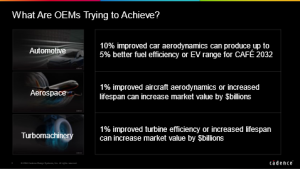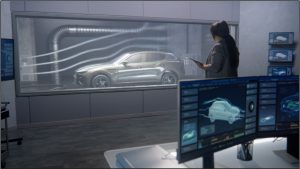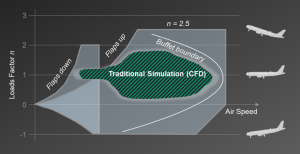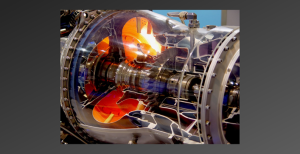We are at a global inflection point as we cope with the limitations of energy supply and the consequences of climate change. Regional conflicts are elevating risks in the traditional crude oil supply chain. Changes in rainfall patterns and disputes over water use priorities are limiting hydroelectric power generation. Moreover, extreme weather events have intensified the threat to lives and property. These challenges are compelling us to focus on energy efficiency requirements in almost everything we do. As a result, there is a significant trend towards designing more energy-efficient transportation and generation equipment.
Designing Energy-Efficient Machinery
Each industry has its goals to respond to these trends. The automotive industry is investing in electric vehicles and enhancing the aerodynamic efficiency of all their vehicles. The aerospace industry aims to reduce the cost and time required to design new aircraft models that are efficient and durable. In the same vein, the turbomachine industry benefits significantly from every efficiency and extension improvement of the product lifecycle.

Automotive Design
The automotive industry must comply with the new CAFÉ standards for 2028 and 2032. These standards will have an impact on their fleet, meaning they will need to build electric vehicles and improve the average fuel efficiency for their internal combustion engine models. A 10% reduction in the aerodynamic drag coefficient can lead to a 5% improvement in fuel economy. Simulation is a crucial tool to ensure that the design will perform well once manufactured and tested in the wind tunnel.

To achieve this kind of leap forward, the industry must be able to do the following:
- Simulate turbulent air in fine detail
- Evaluate 100s of precise aerodynamic design changes
- Simulate entire car design for net impact
Aircraft Design
The commercial aircraft industry is highly regulated with a focus on safety and environmental impact. The process of designing a new aircraft involves several steps that must meet requirements for safe function, performance, and operation, and the aircraft must be certified for the entire flight envelope. Simulation is the only way to ensure the aircraft will perform as intended before building and flight-testing a prototype.

To simulate all operating conditions, designers must:
- Simulate lift in turbulent air in fine detail
- Simulate the entire aircraft design for net impact
- Evaluate all operating conditions (see chart)
Turbomachinery Design
Turbomachinery includes energy generators, large turbine aircraft engines, marine engines, and other machines with rotating motion. Improving energy efficiency can yield significant returns because of the scaled impact of the machine over its lifetime. Similarly, designing machines to last longer and require less maintenance can have a significant economic impact. Simulation is the best way to analyze various design changes to optimize the final design outcome.

To achieve this kind of leap forward, the industry must be able to:
- Evaluate multiple design optimization tradeoffs
- Simulate combustion dynamics in fine detail
- Simulate a full engine design for net impact
Announcing the Millennium Enterprise Multiphysics Platform
To address these needs, we are announcing the world’s first accelerated digital twin, delivering unprecedented performance and energy efficiency—the Cadence Millennium Enterprise Multiphysics Platform. Targeted at one of the biggest opportunities for greater performance and efficiency, the first-generation Cadence Millennium M1 CFD Supercomputer accelerates high-fidelity computational fluid dynamics (CFD) simulations. Available in the cloud or on-premises, this turnkey solution includes graphics processing units (GPUs) from leading providers, extremely fast interconnections, and an enhanced Cadence high-fidelity CFD software stack optimized for GPU acceleration and generative AI. By fusing Millennium M1 instances into a unified cluster, customers can achieve an unprecedented same-day turnaround time and near-linear scalability when simulating complex mechanical systems.
The Millennium Platform addresses the performance and efficiency needs of the automotive, aerospace and defense (A&D), energy, and turbomachinery industries with critical advances in multiphysics simulation technology. Performance, accuracy, capacity, and accelerated computing are all essential to enabling digital twin simulations that explore more design innovations, providing confidence that they will function as intended before undertaking prototype development and testing.
Highlights and benefits include:
- Performance: Combines best-in-class GPU-resident CFD solvers with dedicated GPU hardware to provide supercomputer-equivalent throughput per GPU of up to 1000 CPU cores
- Efficiency: Reduces turnaround time from weeks to hours with 20X better energy efficiency compared to its CPU equivalent
- Accuracy: Leverages Cadence Fidelity CFD solvers to provide unmatched accuracy to address complex simulation challenges
- High-Performance Computing: Built with extensible architecture and massively scalable Fidelity solvers to provide near-linear scalability on multiple GPU nodes
- AI Digital Twin: Rapid generation of high-quality multiphysics data enables generative AI to create fast and reliable digital twin visualizations of the optimal system design solution
- Turnkey Solution: The industry’s first solution that couples GPU compute with modern and scalable CFD solvers, providing an optimized environment for accelerated CFD and multidisciplinary design and optimization
Flexibility: Available with GPUs from leading vendors, in the cloud with a minimum 8-GPU configuration or on-premises with a minimum 32-GPU configuration—providing a flexible and scalable solution to fit each customer’s deployment needs








